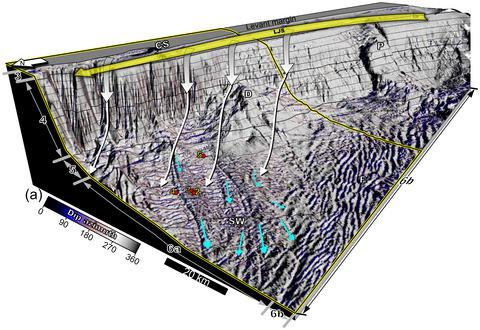当前位置:
X-MOL 学术
›
Basin Res.
›
论文详情
Our official English website, www.x-mol.net, welcomes your feedback! (Note: you will need to create a separate account there.)
Sedimentary response of the deep eastern Mediterranean basin to the north African desertification, sea level variation and regional tectonics
Basin Research ( IF 3.2 ) Pub Date : 2021-11-12 , DOI: 10.1111/bre.12635 U. Schattner 1 , M. Kanari 1, 2 , B.N. Goodman‐Tchernov 1 , M.M. de Mahiques 3, 4 , A. Bernhardt 5
Basin Research ( IF 3.2 ) Pub Date : 2021-11-12 , DOI: 10.1111/bre.12635 U. Schattner 1 , M. Kanari 1, 2 , B.N. Goodman‐Tchernov 1 , M.M. de Mahiques 3, 4 , A. Bernhardt 5
Affiliation

|
The buildup of a continental rise and its morphological patterns depend on sediment transport and deposition via downslope slumps, turbidity currents, along-slope contourites and other deepwater currents. These delivery mechanisms are central to source-to-sink reconstructions, yet untangling their individual roles is not straightforward. The current study focuses on the sink section of the Nile system at the northern Levant continental rise (eastern Mediterranean). During the Pliocene, fluvial systems from northern Africa and the Levant margin supplied sediments to the study area. This supply decreased significantly during the Quaternary because of two processes: (a) The aridification of North Africa made the Nile River the predominant contributor to the basin; (b) the topographic rise of the Levant landmass severely limited fluvial supply. Meanwhile, on-going counter-clockwise marine currents became the prevalent supply system to the Levant margin, and downslope sediment-transport became the only source to the northern Levant continental rise, which became a significant sink of the larger Nile system. These conditions provide an excellent natural laboratory for understanding the individual role of downslope sediment-transport processes in building a continental rise. This research is based on single-channel sparker seismic data, multibeam bathymetry and four 7–8 m long piston-cores collected over the northern Levant continental rise at water depths of 1200–1800 m, together with available multibeam bathymetry and industrial multi-channel seismic reflection data. The results show a major depositional changeover during the Pliocene-Quaternary transition from concordant aggradation to repeated deposition of >12 sediment wave subunits, interpreted as upslope migrating cyclic steps. Quantitative analysis of the sediment wave morphology at the seafloor and subsurface, along with core data, indicates that the immediate sediment source was the nearby shelf. The supply was regulated by basinward-landward shifts of the shore-parallel marine currents during lowstand-highstand conditions (respectively). Hence, this case study highlights the connection between sea-level change and sedimentation patterns on a continental rise.
中文翻译:

地中海东部深盆地对北非荒漠化、海平面变化和区域构造的沉积响应
大陆隆起的形成及其形态模式取决于通过下坡滑坡、浊流、沿坡等高线和其他深水流的沉积物输送和沉积。这些交付机制是源到汇重建的核心,但解开它们各自的角色并不简单。目前的研究重点是位于黎凡特大陆隆起北部(地中海东部)的尼罗河系统下沉部分。在上新世,来自北非和黎凡特边缘的河流系统为研究区提供了沉积物。由于两个过程,这一供应在第四纪显着减少: (a) 北非的干旱化使尼罗河成为流域的主要贡献者;(b) 黎凡特大陆的地形上升严重限制了河流供应。与此同时,持续的逆时针洋流成为黎凡特边缘的主要供应系统,下坡沉积物输送成为黎凡特北部大陆隆起的唯一来源,成为更大的尼罗河系统的重要汇。这些条件为了解下坡沉积物运输过程在建立大陆隆起中的个人作用提供了一个极好的自然实验室。这项研究基于单通道火花地震数据、多波束测深和在 1200-1800 m 水深的黎凡特北部大陆隆起上收集的四个 7-8 m 长的活塞岩心,以及可用的多波束测深和工业多通道地震反射数据。结果表明,在上新世-第四纪从一致加积过渡到>12个沉积波亚基的重复沉积过程中,沉积发生了重大转变,被解释为上坡迁移循环步骤。对海底和地下沉积物波形态的定量分析以及核心数据表明,直接的沉积物来源是附近的大陆架。在低水位 - 高水位条件下(分别),供应受到与海岸平行的海流向盆地 - 陆地移动的调节。因此,本案例研究强调了海平面变化与大陆上升沉积模式之间的联系。连同核心数据,表明直接的沉积物来源是附近的大陆架。在低水位 - 高水位条件下(分别),供应受到与海岸平行的海流向盆地 - 陆地移动的调节。因此,本案例研究强调了海平面变化与大陆上升沉积模式之间的联系。连同核心数据,表明直接的沉积物来源是附近的大陆架。在低水位 - 高水位条件下(分别),供应受到与海岸平行的海流向盆地 - 陆地移动的调节。因此,本案例研究强调了海平面变化与大陆上升沉积模式之间的联系。
更新日期:2021-11-12
中文翻译:

地中海东部深盆地对北非荒漠化、海平面变化和区域构造的沉积响应
大陆隆起的形成及其形态模式取决于通过下坡滑坡、浊流、沿坡等高线和其他深水流的沉积物输送和沉积。这些交付机制是源到汇重建的核心,但解开它们各自的角色并不简单。目前的研究重点是位于黎凡特大陆隆起北部(地中海东部)的尼罗河系统下沉部分。在上新世,来自北非和黎凡特边缘的河流系统为研究区提供了沉积物。由于两个过程,这一供应在第四纪显着减少: (a) 北非的干旱化使尼罗河成为流域的主要贡献者;(b) 黎凡特大陆的地形上升严重限制了河流供应。与此同时,持续的逆时针洋流成为黎凡特边缘的主要供应系统,下坡沉积物输送成为黎凡特北部大陆隆起的唯一来源,成为更大的尼罗河系统的重要汇。这些条件为了解下坡沉积物运输过程在建立大陆隆起中的个人作用提供了一个极好的自然实验室。这项研究基于单通道火花地震数据、多波束测深和在 1200-1800 m 水深的黎凡特北部大陆隆起上收集的四个 7-8 m 长的活塞岩心,以及可用的多波束测深和工业多通道地震反射数据。结果表明,在上新世-第四纪从一致加积过渡到>12个沉积波亚基的重复沉积过程中,沉积发生了重大转变,被解释为上坡迁移循环步骤。对海底和地下沉积物波形态的定量分析以及核心数据表明,直接的沉积物来源是附近的大陆架。在低水位 - 高水位条件下(分别),供应受到与海岸平行的海流向盆地 - 陆地移动的调节。因此,本案例研究强调了海平面变化与大陆上升沉积模式之间的联系。连同核心数据,表明直接的沉积物来源是附近的大陆架。在低水位 - 高水位条件下(分别),供应受到与海岸平行的海流向盆地 - 陆地移动的调节。因此,本案例研究强调了海平面变化与大陆上升沉积模式之间的联系。连同核心数据,表明直接的沉积物来源是附近的大陆架。在低水位 - 高水位条件下(分别),供应受到与海岸平行的海流向盆地 - 陆地移动的调节。因此,本案例研究强调了海平面变化与大陆上升沉积模式之间的联系。

























 京公网安备 11010802027423号
京公网安备 11010802027423号